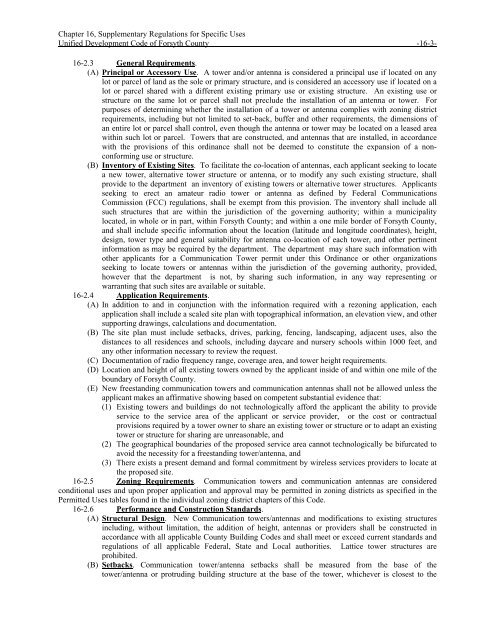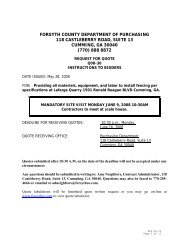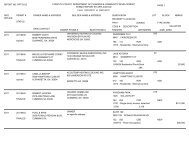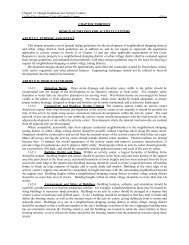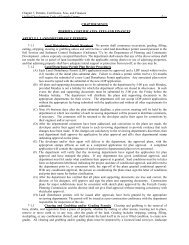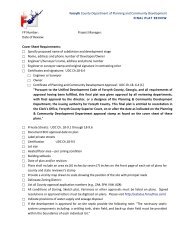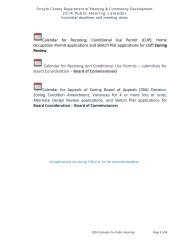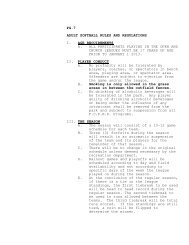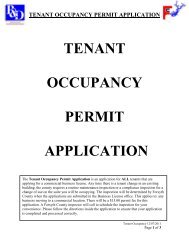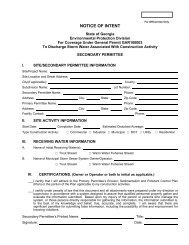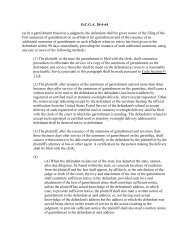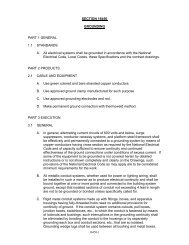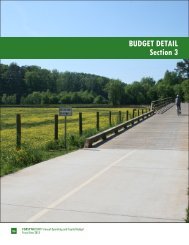Complete UDC - Forsyth County Government
Complete UDC - Forsyth County Government
Complete UDC - Forsyth County Government
Create successful ePaper yourself
Turn your PDF publications into a flip-book with our unique Google optimized e-Paper software.
Chapter 16, Supplementary Regulations for Specific Uses<br />
Unified Development Code of <strong>Forsyth</strong> <strong>County</strong> -16-3-<br />
16-2.3 General Requirements.<br />
(A) Principal or Accessory Use. A tower and/or antenna is considered a principal use if located on any<br />
lot or parcel of land as the sole or primary structure, and is considered an accessory use if located on a<br />
lot or parcel shared with a different existing primary use or existing structure. An existing use or<br />
structure on the same lot or parcel shall not preclude the installation of an antenna or tower. For<br />
purposes of determining whether the installation of a tower or antenna complies with zoning district<br />
requirements, including but not limited to set-back, buffer and other requirements, the dimensions of<br />
an entire lot or parcel shall control, even though the antenna or tower may be located on a leased area<br />
within such lot or parcel. Towers that are constructed, and antennas that are installed, in accordance<br />
with the provisions of this ordinance shall not be deemed to constitute the expansion of a nonconforming<br />
use or structure.<br />
(B) Inventory of Existing Sites. To facilitate the co-location of antennas, each applicant seeking to locate<br />
a new tower, alternative tower structure or antenna, or to modify any such existing structure, shall<br />
provide to the department an inventory of existing towers or alternative tower structures. Applicants<br />
seeking to erect an amateur radio tower or antenna as defined by Federal Communications<br />
Commission (FCC) regulations, shall be exempt from this provision. The inventory shall include all<br />
such structures that are within the jurisdiction of the governing authority; within a municipality<br />
located, in whole or in part, within <strong>Forsyth</strong> <strong>County</strong>; and within a one mile border of <strong>Forsyth</strong> <strong>County</strong>,<br />
and shall include specific information about the location (latitude and longitude coordinates), height,<br />
design, tower type and general suitability for antenna co-location of each tower, and other pertinent<br />
information as may be required by the department. The department may share such information with<br />
other applicants for a Communication Tower permit under this Ordinance or other organizations<br />
seeking to locate towers or antennas within the jurisdiction of the governing authority, provided,<br />
however that the department is not, by sharing such information, in any way representing or<br />
warranting that such sites are available or suitable.<br />
16-2.4 Application Requirements.<br />
(A) In addition to and in conjunction with the information required with a rezoning application, each<br />
application shall include a scaled site plan with topographical information, an elevation view, and other<br />
supporting drawings, calculations and documentation.<br />
(B) The site plan must include setbacks, drives, parking, fencing, landscaping, adjacent uses, also the<br />
distances to all residences and schools, including daycare and nursery schools within 1000 feet, and<br />
any other information necessary to review the request.<br />
(C) Documentation of radio frequency range, coverage area, and tower height requirements.<br />
(D) Location and height of all existing towers owned by the applicant inside of and within one mile of the<br />
boundary of <strong>Forsyth</strong> <strong>County</strong>.<br />
(E) New freestanding communication towers and communication antennas shall not be allowed unless the<br />
applicant makes an affirmative showing based on competent substantial evidence that:<br />
(1) Existing towers and buildings do not technologically afford the applicant the ability to provide<br />
service to the service area of the applicant or service provider, or the cost or contractual<br />
provisions required by a tower owner to share an existing tower or structure or to adapt an existing<br />
tower or structure for sharing are unreasonable, and<br />
(2) The geographical boundaries of the proposed service area cannot technologically be bifurcated to<br />
avoid the necessity for a freestanding tower/antenna, and<br />
(3) There exists a present demand and formal commitment by wireless services providers to locate at<br />
the proposed site.<br />
16-2.5 Zoning Requirements. Communication towers and communication antennas are considered<br />
conditional uses and upon proper application and approval may be permitted in zoning districts as specified in the<br />
Permitted Uses tables found in the individual zoning district chapters of this Code.<br />
16-2.6 Performance and Construction Standards.<br />
(A) Structural Design. New Communication towers/antennas and modifications to existing structures<br />
including, without limitation, the addition of height, antennas or providers shall be constructed in<br />
accordance with all applicable <strong>County</strong> Building Codes and shall meet or exceed current standards and<br />
regulations of all applicable Federal, State and Local authorities. Lattice tower structures are<br />
prohibited.<br />
(B) Setbacks. Communication tower/antenna setbacks shall be measured from the base of the<br />
tower/antenna or protruding building structure at the base of the tower, whichever is closest to the


